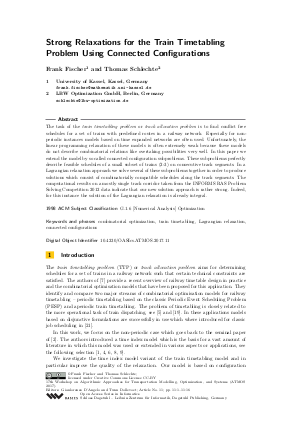Strong Relaxations for the Train Timetabling Problem Using Connected Configurations
Authors Frank Fischer, Thomas Schlechte
-
Part of:
Volume:
17th Workshop on Algorithmic Approaches for Transportation Modelling, Optimization, and Systems (ATMOS 2017)
Part of: Series: Open Access Series in Informatics (OASIcs)
Part of: Conference: Symposium on Algorithmic Approaches for Transportation Modelling, Optimization, and Systems (ATMOS) - License:
 Creative Commons Attribution 3.0 Unported license
Creative Commons Attribution 3.0 Unported license
- Publication Date: 2017-09-04
File

PDF
OASIcs.ATMOS.2017.11.pdf
- Filesize: 3.39 MB
- 16 pages
Document Identifiers
Subject Classification
Keywords
- combinatorial optimization
- train timetabling
- Lagrangian relaxation
- connected configurations
Metrics
- Access Statistics
-
Total Accesses (updated on a weekly basis)
0Document
0Metadata
Abstract
The task of the train timetabling problem or track allocation problem is to find conflict free schedules for a set of trains with predefined routes in a railway network. Especially for non-periodic instances models based on time expanded networks are often used. Unfortunately, the linear programming relaxation of these models is often extremely weak because these models do not describe combinatorial relations like overtaking possibilities very well. In this paper we extend the model by so called connected configuration subproblems. These subproblems perfectly describe feasible schedules of a small subset of trains (2-3) on consecutive track segments. In a Lagrangian relaxation approach we solve several of these subproblems together in order to produce solutions which consist of combinatorially compatible schedules along the track segments. The computational results on a mostly single track corridor taken from the INFORMS RAS Problem Solving Competition 2012 data indicate that our new solution approach is rather strong. Indeed, for this instance the solution of the Lagrangian relaxation is already integral.
Cite As Get BibTex
Frank Fischer and Thomas Schlechte. Strong Relaxations for the Train Timetabling Problem Using Connected Configurations. In 17th Workshop on Algorithmic Approaches for Transportation Modelling, Optimization, and Systems (ATMOS 2017). Open Access Series in Informatics (OASIcs), Volume 59, pp. 11:1-11:16, Schloss Dagstuhl – Leibniz-Zentrum für Informatik (2017)
https://doi.org/10.4230/OASIcs.ATMOS.2017.11
BibTex
@InProceedings{fischer_et_al:OASIcs.ATMOS.2017.11,
author = {Fischer, Frank and Schlechte, Thomas},
title = {{Strong Relaxations for the Train Timetabling Problem Using Connected Configurations}},
booktitle = {17th Workshop on Algorithmic Approaches for Transportation Modelling, Optimization, and Systems (ATMOS 2017)},
pages = {11:1--11:16},
series = {Open Access Series in Informatics (OASIcs)},
ISBN = {978-3-95977-042-2},
ISSN = {2190-6807},
year = {2017},
volume = {59},
editor = {D'Angelo, Gianlorenzo and Dollevoet, Twan},
publisher = {Schloss Dagstuhl -- Leibniz-Zentrum f{\"u}r Informatik},
address = {Dagstuhl, Germany},
URL = {https://drops.dagstuhl.de/entities/document/10.4230/OASIcs.ATMOS.2017.11},
URN = {urn:nbn:de:0030-drops-79021},
doi = {10.4230/OASIcs.ATMOS.2017.11},
annote = {Keywords: combinatorial optimization, train timetabling, Lagrangian relaxation, connected configurations}
}
Author Details
References
- Ralf Borndörfer and Thomas Schlechte. Models for railway track allocation. In Christian Liebchen, Ravindra K. Ahuja, and Juan A. Mesa, editors, ATMOS 2007 - 7th Workshop on Algorithmic Approaches for Transportation Modeling, Optimization, and Systems, volume 7 of OpenAccess Series in Informatics (OASIcs). Schloss Dagstuhl - Leibniz-Zentrum für Informatik, 2007. URL: http://www.dagstuhl.de/dagpub/978-3-939897-04-0, URL: http://dx.doi.org/10.4230/OASIcs.ATMOS.2007.1170.
-
Ulf Brännlund, Per Olov Lindberg, Andreas Nou, and Jan-Eric Nilsson. Railway timetabling using Lagrangian relaxation. Transportation Science, 32(4):358-369, 1998.

- Valentina Cacchiani, Alberto Caprara, and Paolo Toth. Non-cyclic train timetabling and comparability graphs. Operations Research Letters, 38(3):179-184, 2010. URL: http://dx.doi.org/10.1016/j.orl.2010.01.007.
-
Valentina Cacchiani, Alberto Caprara, and Paolo Toth. Scheduling extra freight trains on railway networks. Transportation Research Part B: Methodological, 44(2):215-231, 2010.

- Valentina Cacchiani, Dennis Huisman, Martin Kidd, Leo Kroon, Paolo Toth, Lucas Veelenturf, and Joris Wagenaar. An overview of recovery models and algorithms for real-time railway rescheduling. Transportation Research Part B: Methodological, 63:15-37, 2014. URL: http://dx.doi.org/10.1016/j.trb.2014.01.009.
-
Valentina Cacchiani and Paolo Toth. Nominal and robust train timetabling problems. European Journal of Operational Research, 219(3):727-737, 2012.

- Gabrio Caimi, Leo G. Kroon, and Christian Liebchen. Models for railway timetable optimization: Applicability and applications in practice. JRTPM, 6(4):285-312, 2017. URL: http://dx.doi.org/10.1016/j.jrtpm.2016.11.002.
-
Alberto Caprara, Matteo Fischetti, and Paolo Toth. Modeling and solving the train timetabling problem. Operations Research, 50(5):851-861, 2002.

- Alberto Caprara, Michele Monaci, Paolo Toth, and Pier Luigi Guida. A Lagrangian heuristic algorithm for a real-world train timetabling problem. Discrete Appl. Math., 154(5):738-753, 2006. URL: http://dx.doi.org/10.1016/j.dam.2005.05.026.
- Wellington de Oliveira, Claudia Sagastizábal, and Claude Lemaréchal. Convex proximal bundle methods in depth: a unified analysis for inexact oracles. Mathematical Programming, 148(1):241-277, 2014. URL: http://dx.doi.org/10.1007/s10107-014-0809-6.
- Frank Fischer. Dynamic Graph Generation and an Asynchronous Parallel Bundle Method Motivated by Train Timetabling. PhD thesis, Chemnitz University of Technology, 2013. URL: http://nbn-resolving.de/urn:nbn:de:bsz:ch1-qucosa-118358.
- Frank Fischer. Ordering constraints in time expanded networks for train timetabling problems. In Giuseppe F. Italiano and Marie Schmidt, editors, 15th Workshop on Algorithmic Approaches for Transportation Modelling, Optimization, and Systems, ATMOS 2015, September 17, 2015, Patras, Greece, volume 48 of OpenAccess Series in Informatics (OASIcs), pages 97-110. Schloss Dagstuhl - Leibniz-Zentrum für Informatik, 2015. URL: http://www.dagstuhl.de/dagpub/978-3-939897-99-6, URL: http://dx.doi.org/10.4230/OASIcs.ATMOS.2015.97.
- Frank Fischer. DynG Dynamic Graph Generation library 0.4.1, 2017. URL: http://www.mathematik.uni-kassel.de/~fifr/fossils/cpp-dyng.
- Frank Fischer and Christoph Helmberg. Dynamic graph generation for the shortest path problem in time expanded networks. Mathematical Programming A, 143(1-2):257-297, 2014. URL: http://dx.doi.org/10.1007/s10107-012-0610-3.
- Frank Fischer and Christoph Helmberg. A parallel bundle framework for asynchronous subspace optimization of nonsmooth convex functions. SIAM Journal on Optimization, 24(2):795-822, 2014. URL: http://dx.doi.org/10.1137/120865987.
- Christoph Helmberg. ConicBundle 0.3.11. Fakultät für Mathematik, Technische Universität Chemnitz, 2012. URL: http://www.tu-chemnitz.de/~helmberg/ConicBundle.
-
Jean-Baptiste Hiriart-Urruty and Claude Lemaréchal. Convex Analysis and Minimization Algorithms I &II, volume 305, 306 of Grundlehren der mathematischen Wissenschaften. Springer, Berlin, Heidelberg, 1993.

- IBM ILOG CPLEX 12.7, User’s Manual for CPLEX, 2016. URL: https://www.ibm.com/support/knowledgecenter/SSSA5P_12.7.0.
- Leonardo Lamorgese, Carlo Mannino, and Mauro Piacentini. Optimal train dispatching by Benders'-like reformulation. Transportation Science, 50(3):910-925, 2016. URL: http://dx.doi.org/10.1287/trsc.2015.0605.
- Sascha G. Lukac. Holes, antiholes and maximal cliques in a railway model for a single track. Technical Report ZIB Report 04-18, Zuse-Institut Berlin, Takustr. 7, 14195 Berlin, 2004. URL: http://www.zib.de/PaperWeb/abstracts/ZR-04-18.
- Alessandro Mascis and Dario Pacciarelli. Job-shop scheduling with blocking and no-wait constraints. European Journal of Operational Research, 143(3):498-517, 2002. URL: http://dx.doi.org/10.1016/S0377-2217(01)00338-1.
- RAS Problem Solving Competition 2012, 2012. URL: https://www.informs.org/Community/RAS/Problem-Solving-Competition/2012-RAS-Problem-Solving-Competition.
- TTPlib-Homepage, 2008. URL: http://ttplib.zib.de.
